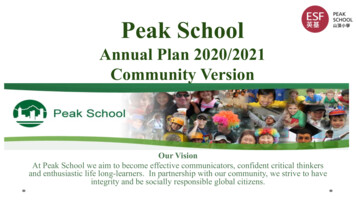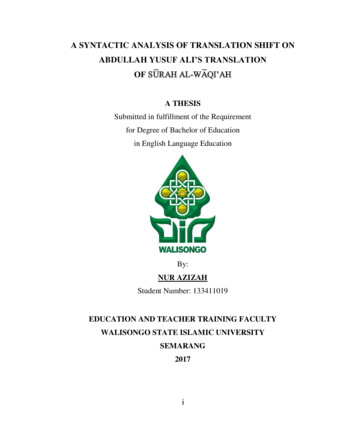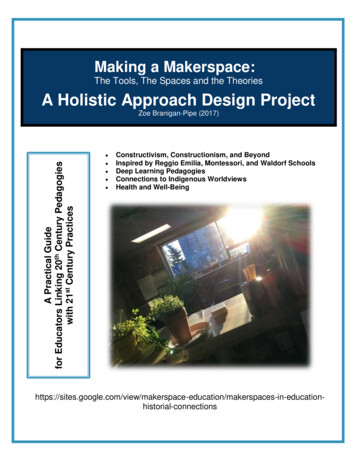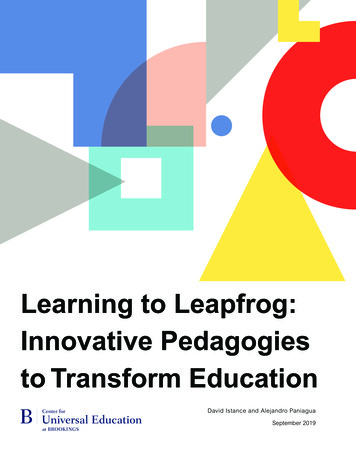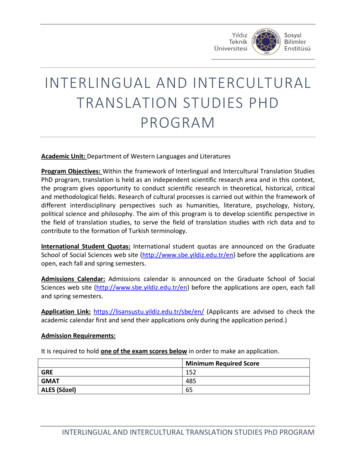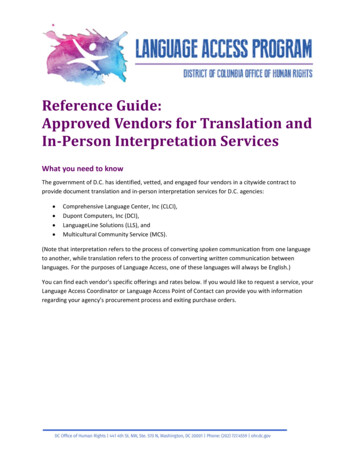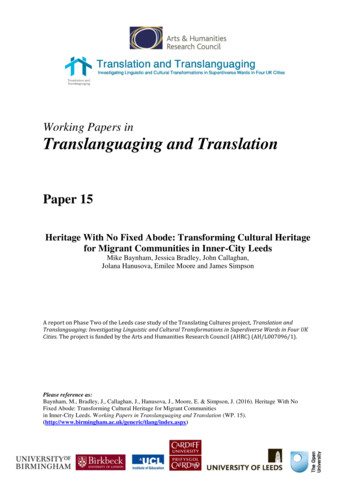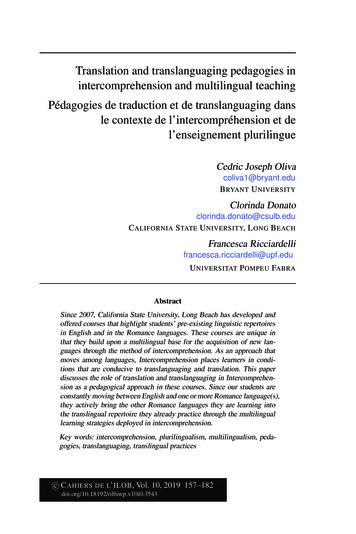
Transcription
Translation and translanguaging pedagogies inintercomprehension and multilingual teachingPédagogies de traduction et de translanguaging dansle contexte de l’intercompréhension et del’enseignement plurilingueCedric Joseph Olivacoliva1@bryant.eduB RYANT U NIVERSITYClorinda DonatoC ALIFORNIAclorinda.donato@csulb.eduS TATE U NIVERSITY, L ONG B EACHFrancesca Ricciardellifrancesca.ricciardelli@upf.eduU NIVERSITAT P OMPEU FABRAAbstractSince 2007, California State University, Long Beach has developed andoffered courses that highlight students’ pre-existing linguistic repertoiresin English and in the Romance languages. These courses are unique inthat they build upon a multilingual base for the acquisition of new languages through the method of intercomprehension. As an approach thatmoves among languages, Intercomprehension places learners in conditions that are conducive to translanguaging and translation. This paperdiscusses the role of translation and translanguaging in Intercomprehension as a pedagogical approach in these courses. Since our students areconstantly moving between English and one or more Romance language(s),they actively bring the other Romance languages they are learning intothe translingual repertoire they already practice through the multilinguallearning strategies deployed in intercomprehension.Key words: intercomprehension, plurilingualism, multilingualism, pedagogies, translanguaging, translingual practicesc C AHIERSDE L’ ILOB , Vol. 10, 2019doi.org/10.18192/olbiwp.v10i0.3543157–182
C AHIERSDE L’ILOBOLBI W ORKING PAPERSRésuméDepuis 2007, California State University, Long Beach développe et offredes cours qui mettent en avant le répertoire linguistique préexistant desétudiants en anglais et en langues romanes. Ces cours sont uniques, carils s’appuient sur un répertoire multilingue pour permettre l’acquisitionde nouvelles langues à travers la méthode d’intercompréhension. L’intercompréhension, approche transcendant les barrières entre les langues,offre aux apprenants un contexte propice au translanguaging et à la traduction. Cet article discute du rôle de la traduction et du translanguaging dans l’intercompréhension. Étant donné que nos étudiants naviguentconstamment entre l’anglais et une (ou, des) langue(s) romanes(s), ilsfont ainsi entrer de manière active les tierces langues romanes en coursd’apprentissage dans le répertoire translangagier qu’ils utilisent déjà parle biais des stratégies intercompréhensives.Mots-clés : intercompréhension, plurilinguisme, multilinguisme, pédagogies, translanguaging, pratiques translangagièresIntroduction and backgroundThe presence of Spanish in any number of urban landscapes across the UnitedStates bespeaks a unique set of geo-historical contexts characterized by conquest, displacement, return, migration, and geographical proximities, such asthose that prevail in borderlands — that is, the current highly fraught situationon the Mexican–U.S. border. The confluence of so many factors in the mappingof Spanish and its vitality today in the United States constitutes a veritable language geography whose contours have become increasingly visible and mainstream, indeed, the condition of new language geographies that Simon (2012)has spoken about in Cities in translation: Intersections of language and memory to describe “topographies of language and their power to mark the urbanlandscape” (p. xix). Throughout the United States and to some extent Canadaas well, Spanish has become an element of a new language geography that ischanging the linguistic landscape of every sector of life and culture. Certain areas of the United States, such as some sectors of California, Florida, and NewYork, can be considered both Spanish-speaking and English-speaking in equalmeasure. The ways in which new language geographies generate new languagepractices has been at the forefront of García’s research. Her observations ofchildren in multilingual contexts revealed their unified language repertoire andtheir natural movement within it. Designated as translanguaging, echoing thework of Williams (1994), this movement among languages in one’s repertoirehas established a new paradigm for the study of language acquisition, whichhas engendered a highly nuanced terrain for innovative research as the contributions to this volume demonstrate.158Vol. 10, 2019
O LIVAET AL .Pedagogies in intercomprehension/l’enseignement plurilingueIn this article, we relate our work on the use of translation and translanguaging pedagogies in language acquisition among multi- and plurilinguallearners (García, 2007). At California State University, Long Beach (CSULB)in Southern California, a geographical region where growing numbers of students in educational institutions at every level are emerging English–Spanishbilinguals, we have developed teaching pedagogies that work in tandem witha student’s entire linguistic repertoire to teach languages that are typologicallysimilar to Spanish, in this case, French and Italian. This article focuses on thecourses we have developed — “French and Italian for speakers of English andSpanish,” and “Intercomprehension among Romance languages” — as well asthe materials we have used, and those we have created for teaching in multiple languages. Data from the teaching of the intercomprehension course atSt. Lawrence University in upstate New York is also included.The emergence of new perspectives and opportunitiesfor a growing audienceAs keynote speaker at the 2011 Kentucky Foreign Language Conference, MaryLouise Pratt delivered the lecture “Globalization as linguistic force field,” inwhich she offered several examples from hip-hop and rap music where the multiple languages of the artists formed translanguaging texts widely embracedacross North America (Pratt, 2011, p. 6). Pratt referenced the dissemination ofthis urban, multilingual, and multicultural music as the bellwether for globalmusic. Indeed, what was a trend in 2011 has become a solidly entrenchednew paradigm for music in 2019. The bilingual phenomenon has continued toevolve in urban music to such a point that the English and Spanish musical markets are destined to become unified, as increasing numbers of English-languagesingers produce music in Spanish for the burgeoning Spanish-language market,and Spanish rap artists and rhythms, such as Reggaeton and Latin rap continueto garner audiences and emulators worldwide.1 Some fifty years following theBritish invasion in music, we witness now the Spanish–English invasion, wherea translanguaging rap version of “I like it like that” (Pabon & Rodriguez, 1967)reached number one in 2018. Its signature feature resides in the ability of thethree rappers, Cardi B, J. Balvin, and Bad Bunny, to rap seamlessly in Spanish–English, a talent that many artists, including Justin Bieber and Rihanna, seekto replicate in their own work. The success of bilingual music over the lastfew years demonstrates the power of new language geographies to create anddisseminate cultural products that reflect the reality of an expanded linguistic repertoire for greater numbers of citizens. News outlets had been reporting1We note that Reggaeton music originated in the late 1990s in Puerto Rico and theCaribbean. It is characterized by rapping and singing in Spanish.Vol. 10, 2019159
C AHIERSDE L’ILOBOLBI W ORKING PAPERSon the demographic shifts for some time. In April 2014, CNN sparked mediaattention after featuring an article entitled “California’s Hispanic milestone”(Ruben, 2014) announcing a major demographic shift in the state of California, where the Hispanic population would soon become predominant. A yearlater, the New York Post noted that the United States accounted a higher number of Spanish speakers than Spain (Perez, 2015). Indeed, the Post’s articlereported the results from a study conducted by the Instituto Cervantes that estimated an all-inclusive Spanish speaking population of 56.2 million people(including native, heritage, and academic speakers), thus placing the UnitedStates as the second most populated Spanish speaking country in the worldafter Mexico (121 million speakers) but more than Colombia (48 million) andSpain (46 million).Yet, the socio-linguistic shift which is palpable on the streets and on university campuses is largely ignored in educational institutions, which still consider as problematic the use of any language other than English as the educational point of reference. Particularly in the language classroom, bilingualand multilingual students are asked to forget that their linguistic repertoire includes languages other than English. In this context, Hispanic-serving institutions such as CSULB — which reports a student body that is over 40% Hispanic (California State University, 2019) — seek ways to better integrate students with bilingual and bicultural profiles by presenting them with teachingand learning strategies that allow them to work from these linguistic profiles aspoints of strength. Thanks to the favourable demographic conjuncture (Oliva &Donato, 2015) in the university’s Department of Romance, German, RussianLanguages and Literature, the support of the Services Culturels du Consulat deFrance à Los Angeles, and a three-year National Endowment for Humanitiesgrant, we were able to address the growing numbers of Spanish-speaking students in pedagogically inclusive ways in our French and Italian classes. Themost immediate objective was to offer bilingual students introductory- andintermediate-level curricula specifically tailored for speakers of English andSpanish. In this endeavour, French and Italian courses were adapted to the students’ existing linguistic knowledge as well as their metacognitive (translingual) awareness as experienced bilinguals. While we will discuss both pointsin the next two sections, in this section, we would like to survey the considerable evolution of research in the United States and internationally that hasshed light on multilingual teaching for multilingual students. Acknowledgingthe existence of learners with new linguistic and cultural backgrounds was aturning point in the advancement of research and the development of educational and pedagogical projects (Kramsch, 2009; Kramsch & Zhang, 2018).In many instances, promotion of such projects remains complicated to implement in American institutions as Gramling and Warner described in 2015:160Vol. 10, 2019
O LIVAET AL .Pedagogies in intercomprehension/l’enseignement plurilingue“[a]s a field, critical multilingualism studies has to rely on intergroup, interlingual, transnational, and international research communities. . . . Participants inthese communities often operate in knowledge domains that are ‘structurallyobscured in Anglocentric institutions’ ” (p. 3). In the case of L3 education inEurope, Portolés and Martí (2017, p. 64) note that multilingual education stillabides by monolingual principles. Lemke (2002) remarks that political andideological pressures render the development of multilingual education morecomplicated than it needs to be. Furthermore, pushed by ideological, sociological, or political norms, research and instruction alike have developed a tendency to regard multilingualism as a series of parallel monolingualisms (Bailey, 2007; Grosjean, 2010) which fit nationalistic language archetypes. However, such archetypes contradict the actual linguistic reality of multilingualspeakers who, even when influenced by ideological, social, or political messages about monolingualism, nevertheless experience their language repertoireas whole, no matter how many languages exist within it.Language policies that are unfriendly to multilingualism weigh heavilyupon many potentially multilingual teaching contexts throughout the world.Such cases have been reported in the context of African bilingualism (Makoni& Mashiri, 2007) or Corsican bilingualism (Jaffe, 1999). In Ideologies in action, Jaffe describes advances made in the inclusion of Corsican in all of itsforms as a viable and teachable language. Indeed, Corsican researchers andpolicy-makers advocated for successfully moving away from the commonlyaccepted diglossic perspective and situation in place in the 80s, which offeredan unbalanced power dynamic between French (High) and Corsican (Low)and nurtured, walled-off, social, and educational norms. The developing ideologies lead to the acceptance of polynomic status and approaches to languagevariations on the island. This marks the emergence of an important shift inpolicies where “[t]he concept of polynomy did not advocate a power reversal,but rather, a redefinition of what power was” (p. 186) leading to the acceptance of all variations of Corsican. However, as Jaffe observes, recognition ofhow bilinguals draw from their entire linguistic repertoire when speaking andlearning had not yet entered mainstream thinking about language ideologies.Therefore, these changesrevealed the difficulty of applying the idea of polynomic language against abackdrop of deeply rooted ideas about linguistic legitimacy in the face of practical requirements for teaching. . . . Nor did it seem that tolerance of diversitywas extended to mixed forms, whether they were mixtures of Corsican andFrench or mixtures of Corsican dialects. (Jaffe, 1999, p. 187)The recent efforts of the Belgian school system in offering more diversified and more accessible opportunities for bilingual education is a salient example of actions taken to offer more appropriate policies which place “[l]’éduVol. 10, 2019161
C AHIERSDE L’ILOBOLBI W ORKING PAPERScation bilingue au coeur des politiques linguistiques” (Babault, 2015, p. 38). Infact, research interest is burgeoning, marked by the growing number of journals dedicated to the topic, such as the creation of Critical MultilingualismStudies in 2012, followed by Translation and Translanguaging in MultilingualContexts in 2015, not to mention the large number of articles and monographs(Burck, 2005; Kramsch, 2009; Kramsch & Zhang, 2018). In fact, as early as2005, the pedagogical value and potential of codeswitching was described byLin and Martin (2005). In the context of heritage language learners, Cummins(2005) argues the necessity of adapting bilingual educational strategies to takeinto account the fully functioning cross-linguistic transfers that exist betweentwo languages. All such contributions lend social and educational validity tocodeswitching.In their descriptions of bilingual classrooms, García (2007, 2009) andCreese and Blackledge (2010) evidence the value of the pre-acquired linguistic repertoire of bilinguals and their inherent translanguaging as a linguistic“toolkit” that equips bilingual learners for educational success. Attemptingto eliminate the natural tendency of bilinguals to translanguage, and to impose upon them instead a monolingual identity destroys their inherent capacity to make connections between all of the languages they know and all ofthe languages they are learning. Traditionally, in the context of modern language learners in the United States, monolingual neophyte learners of Frenchwere discouraged from using their knowledge of English to develop translanguaging techniques and skills between English and French. The well-anchored,persistent, and pervasive (still today) preference for “target-language-(only)”approaches removes all languages except the target language from acquisitionstrategies. In the same manner, bilingual (English-Spanish) neophyte learners of French were not encouraged to use their knowledge of English, not tomention Spanish, or their predisposition to use interlanguaging pathways between English, Spanish, “Spanglish” and French as they acquired the language.Most commonly used textbooks offer no tools or approaches that elicit suchconnections.In the case of L3 acquisition, the next section sheds light on the advantages that flexible and customized approaches offer in the acquisition process.It shows how the use of all pre-acquired languages, as well as connectionsexisting among typologically similar languages, become an asset for learning. The journal Translation and Translanguaging in Multilingual Contextspresents translanguaging and translation, not only as communicative phenomena but also as “advanced pedagogies” that embrace the co-existence of multiple languages in the implementation and creation of pedagogical approaches.The courses, teaching pedagogies, and materials produced in this article reflectthese principles.162Vol. 10, 2019
O LIVAET AL .Pedagogies in intercomprehension/l’enseignement plurilingueL’enseignement du français, de l’italien et du portugais pour locuteursanglo-hispanophones : de nouveaux buts pour les programmes delanguesPour nous adapter au contexte décrit dans la précédente section, nous avonscréé une offre pédagogique intégralement repensée et restructurée qui tientcompte du nombre toujours grandissant d’étudiants bilingues et surtout anglohispanophones (Oliva, 2014–2016; Donato et Oliva, 2016; Oliva et Donato,2015). Depuis la rentrée de l’automne 2007, nous avons créé un cours expérimental de français de premier semestre débutant (100A) spécialement conçupour ces étudiants bilingues. Au printemps 2008, s’en suivait la création ducours de premier semestre débutant (100A) d’italien. Le succès de ces cours niveau débutant nous a menés au développement d’un programme d’étude complet de trois semestres (débutant et intermédiaire) en français puis en italien.Dès le semestre du printemps 2009, nous offrions déjà tous les niveaux (100A,100B et 200) dans les deux langues. Traditionnellement, nos programmes débutant et intermédiaire s’effectuent en quatre semestres d’enseignement. Maisces programmes répondant aux besoins des étudiants bilingues, nous ont permis de prendre en considération les capacités particulières de ces étudiants etde créer un programme intensif et accéléré permettant de couvrir le contenu dequatre semestres en trois semestres (Fig. 1).F IGURE 1Comparaison du cursus traditionnel et du cursus dit « anglo-hispanophone » auxniveaux débutant (100/101) et intermédiaire (200/201)Du fait que ces cours soient basés sur une approche intercompréhensive(Fig. 5), il existe une certaine marge de manœuvre concernant les compétencesprérequises nécessaires pour pouvoir les suivre. La plupart de nos étudiants ontune compétence avancée en espagnol (équivalent 3ème année universitaire),qu’elle soit native, d’héritage académique, ou une combinaison des deux. Dansun esprit de fluidité pédagogique, nous voulions que les étudiants ayant unecompétence linguistique dans une langue proche autre que l’espagnol puissentVol. 10, 2019163
C AHIERSDE L’ILOBOLBI W ORKING PAPERSégalement suivre ces cours. Par exemple, nous avons reçu dans les cours defrançais et d’italien des étudiants luso-anglophones et roumano-anglophones,dans le cours d’italien des franco-anglophones et dans le cours de français desitalo-anglophones. Et aussi quelques rares exceptions comme une étudiantegermano-anglophone et une étudiante monolingue suivant un cursus de baccalauréat en linguistique. Oliva a mené un questionnaire détaillé d’entrée etde sortie de cours durant la période de l’automne 2014 au printemps 2016(Oliva, 2014–2016). Ce questionnaire2 a permis notamment de recueillir lesstatistiques linguistiques des 260 étudiants ayant suivi les cours de langue deniveau débutant et intermédiaire pour « anglo-hispanophones » durant cette période (Fig. 2).Bien que les composantes intercompréhensives (Fig. 5) permettent un certain dégré de fluidité linguistique dans ces cours, ils restent, in fine, des coursde langues avec une focalisation sur le développement de la compétence decommunication en langue cible et suivent les lignes directrices de compétences langagières telles que celles déterminées par l’ACTFL (s.d.). Pour cequi est des transparences lexicales, nous invitons les apprenants à développerdes compétences de lecture avancées en langue cible dès le début de l’enseignement. L’apprentissage avancé de la lecture a une incidence positive sur lestrois autres compétences (Escudé et Janin, 2010). Ce processus se développeautour d’apprentissage permettant de repérer les mots transparents et de négocier les différents niveaux de transparence en déduisant les faux-amis grâceau contexte. Il s’appuie sur les connaissances provenant du répertoire des étudiants, c’est-à-dire les connaissances, en général, de l’anglais et de l’espagnol.L’étude du comportement systématique et des stratégies automatiquementmises en œuvre par les apprenants bilingues nous a permis de réaliser qu’uneapproche uniquement basée sur un « étayage pédagogique » ne pouvait leurconvenir. Par exemple, dans le cadre d’un cours traditionnel traitant des verbespronominaux en français, le modelage progressif de la forme pronominale inclut souvent : une révision des terminaisons verbales au présent et de la conjugaison, un modelage « me/te » (x 1 introductif), une explicitation du conceptde réflexivité, un modelage des autres formes « me/te/se/nous/vous/se » (x 1suite), des exercices de modelage, des exercices d’utilisation, et finalement desexercices communicatifs et/ou des activités de taches. Nos étudiants bilinguesdémontrent, et ce dès les premiers instants, une compréhension précise du x 12Oliva a réalisé un questionnaire d’entrée et de sortie des cours durant quatre semestres (de l’automne 2014 au printemps 2016). Le questionnaire a également permisde récolter des valeurs de connaissances lexicales, grammaticales et métalinguistiquesqui conduiront à d’autres études de résultats. 506 étudiants ont été interrogés dont 260dans les cours spécialisés (français/italien pour locuteurs d’anglais et d’espagnol) et246 dans les cours traditionnels.164Vol. 10, 2019
O LIVAET AL .Pedagogies in intercomprehension/l’enseignement plurilingueAutres langues romanescomme langue dite « mère »4%64%Hispanophones de« langueacadémique »16%Bilinguismeavec l’espagnolcomme languedite « mère »48%31%Bilinguismedit « equilibré »entre espagnolet anglaisBilinguismeavec l’anglaiscomme languedite « mère »62%Hispanophones dit« d’héritage »F IGURE 2Statistiques des connaissances linguistiques des 260 étudiants ayant participés auxcours de français ou d’italien pour anglo-hispanophones de l’automne 2014 auprintemps 2016. (Oliva, 2014–2016, données du questionnaire)et du concept de réflexivité qui est en général déjà acquis et de ses modes etconditions d’utilisation. Les questions et difficultés de nos étudiants se portentprimordialement sur les points de divergences tels que la forme « vous vous »pour les locuteurs hispanophones familiers de « ustedes se » au lieu de « vosotros os. » En effet, dans ce cas, l’approche traditionnelle, n’offre que peu demoyens et d’outils pour permettre aux apprenants de fructifier leur bilinguismepréexistant ; et donc, de se servir de leur répertoire linguistique respectif pourle connecter, par un translanguaging qu’ils appliquent déjà entre l’anglais etl’espagnol, à la langue en cours d’apprentissage.Ces conditions d’apprentissage traditionnelles revenaient donc à faire avancer nos étudiants sur le difficile chemin de l’acquisition d’une langue nouvelletout en leur mettant des œillères. C’est ainsi que dès la mise en place de cescours en 2007, nous avons réalisé que le matériel venant de l’approche pédagogique standardisée que nous utilisions pour ces cours n’était pas suffisammentadapté. En effet, la plupart du matériel didactique disponible offrait sur une approche monolingue, externalisée et cloisonnée qui, pour l’apprentissage d’uneVol. 10, 2019165
C AHIERSDE L’ILOBOLBI W ORKING PAPERSnouvelle langue, jetait donc une ombre sur le répertoire linguistique préétablides étudiants (Fig. 3). L’espagnol en était comme effacé, mis dans une prisonlinguistique, et l’anglais normatif ne pouvait servir que comme référent externepropice aux discussions sur les points grammaticaux ou culturels. Le françaisen cours d’acquisition, l’interlangue parfois même appelé pidgin, bien souventconsidéré comme une version sous-classée et dissociée de la langue commenorme politico-idéologique, y demeurait quasi-perpétuellement en devenir (auniveau qualitatif) de cet élusif niveau standard du locuteur natif.F IGURE 3Perception traditionnelle, cloisonnée et normative du répertoire de l’apprenant(Oliva, 2016)Il est suggéré que, dans le cadre de l’enseignement des langues proches,une approche « consciente » de la grammaire est préférable (Donato et Oliva,2014; Carvalho, Freire et Da Silva, 2016) par rapport à celle inductive provenant du scaffolding de l’approche communicative. Le concept de conscienceet de noticing langagier, comme on le retrouve chez Schmidt et al. (2010),préconise que les processus d’acquisition conscients sont, sinon nécessaires,fortement facilitateurs pour l’acquisition d’une langue. Dans le cas de languesproches, il faut inculquer à l’apprenant comment négocier des différences infimes qui existent entre langues romanes (Carvalho, Freire et Da Silva, 2016).Même si ces dernières ne forment pas nécessairement des obstacles à la communication, elles provoquent bien souvent des erreurs (cf. exemple du « à »prépositionnel en Tableau 1) qui doivent cependant être traitées dans le processus d’apprentissage (Stevens, 1990).Pour l’apprentissage de l’utilisation du futur périphrastique, aussi dit « futur proche » (Tableau 1), bien que la structure anglaise soit remarquablementproche, elle n’en reste pas moins opaque pour un œil non-averti. Or, les apprenants anglo-hispanophones vont immédiatement, avec ou sans l’aide de l’instructeur, trouver une aide dans la structure transparente qu’ils connaissent en166Vol. 10, 2019
O LIVAET AL .Pedagogies in intercomprehension/l’enseignement plurilingueTABLE 1Le futur périphrastique français pour apprenants anglo-hispanophonesEspagnolFrançaisAnglais(Tú) Vas a estudiar en Canadá.Tu vas étudier au Canada.You are going to study in Canada.espagnol. Si les étudiants n’élicitent pas cette proximité par eux-mêmes, l’instructeur met en œuvre des stratégies intercompréhensives qui les portent à ladécouvrir et la comprendre par leur propre efforts grâce au support de l’itinéraire multilingue. En effet, les manuels de texte (Fig. 5) que nous avonsdéveloppés dans le cadre de nos cours de français et d’italien pour locuteursanglo-hispanophones, intitulés Juntos : Italian for speakers of English andSpanish (Donato, Oliva, Zappador-Guerra et Romero, 2014) et Juntos : Frenchfor speakers of English and Spanish (Oliva, Donato, Gomez et Romero, 2015)offrent une approche basée sur les principes de l’intercompréhension (Figs. 5et 7) favorable au translanguaging.Bien que français et espagnol soient, en termes d’intercompréhension, deslangues proches et « transparentes, » elles comportent dans l’exemple du future périphrastique une légère différence syntaxique en ce que l’espagnol requiert l’utilisation du « à » prépositionnel. La nécessité de celui-ci explique bonnombre d’erreurs produites par transfert (que d’aucuns nommeraient « transfert négatif ») de l’espagnol vers le français comme cela pourrait être le casdans l’exemple suivant : « Tu vas à étudier au Canada. »Plutôt que de qualifier ce transfert de « négatif » et tenter de l’éviter intégralement, notre perspective est de profiter de ce transfert translinguistiquepar le biais de language noticing. En termes concrets, nous validons le bonsens linguistique dont fait preuve l’apprenant en trouvant dans ses ressourcespréacquises un mode de production dans la langue cible et nous reconnaissonsl’effort productif de « Tu vas à étudier au Canada » qui démontre clairementque la structure générale du futur périphrastique est déjà acquise. Nous apportons cependant, avec une pédagogie que l’on pourrait nommer « pédagogie de(reconnaissance de) la divergence » (Oliva, 2011), un travail en language noticing. Ce travail peut s’effectuer par la correction de phrases erronées (Fig. 4)ou au travers d’exercices de reconnaissance structurelle multilingue de typeintercompréhensif (Fig. 5). Le résultat reste similaire du fait que les étudiantsapprennent à distinguer les structures grammaticales dissociées entre les deux(ou plus de deux) langues, reconnaissent et intègrent l’élément erronée ou nonnécessaire, et produisent donc des formes valides et dépourvues de transfert dit« négatif » dans la langue cible.Vol. 10, 2019167
C AHIERSDE L’ILOBOLBI W ORKING PAPERSF IGURE 4Pédagogie de la divergence (Oliva, 2011)Dans un esprit semblable à celui de nos travaux, le rapport sur les politiques linguistiques du Conseil de l’Europe qui se focalise sur le cas de l’apprentissage de l’anglais langue seconde ou tierce soutient que le but des programmes de langues devrait être de favoriser le développement de compétencesintégratives et multiples (plurilingues, interculturelles, etc.) (Seidlhofer, 2003).De ce fait, la poursuite d’une compétence de niveau de locuteur natif dans lalangue cible ne devrait pas être la focalisation centrale des programmes delangues étrangères.Les approches ayant pour unique but l’apprentissage niveau natif dans lalangue cible en cloisonnement, porteront à apprendre la langue française avecle moins d’inférences possible de l’anglais, et en n’admettant bien évidemment pas que l’espagnol puisse jouer un rôle dans l’apprentissage (Fig. 3). Or,ces inférences font partie des processus d’apprentissage d’une langue tierce entranslanguaging qui permet de faire rentrer la nouvelle langue dans le cerclede multicompétence (Cook, 1992) des apprenants. En effet, le répertoire linguistique ne peut être perçu comme une série de contenants indépendants ethermétiques, ou « leak proof » (Makoni et Mashiri, 2007) et pour que lesapprenants prospèrent dans leur translanguaging, ils doivent faire preuve de« critical (metacognitive/linguistic) awareness » envers leurs pratiques langagières (Canagarajah, 2011; Donato et Oliva, 2016; García, 2007, 2011; O
In their descriptions of bilingual classrooms, García (2007, 2009) and Creese and Blackledge (2010) evidence the value of the pre-acquired linguis-tic repertoire of bilinguals and their inherent translanguaging as a linguistic

